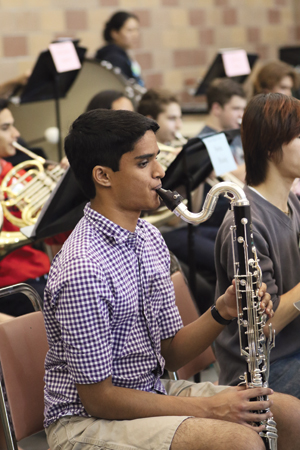 Michael Mark wrote in a March 1968 article in The Instrumentalist, “the bass clarinet is one of the most misunderstood and ignored instruments.” Almost 50 years later and I find that is still the case. Here are some ideas about how to improve the sound of your band by focusing some attention on the bass clarinet.
Michael Mark wrote in a March 1968 article in The Instrumentalist, “the bass clarinet is one of the most misunderstood and ignored instruments.” Almost 50 years later and I find that is still the case. Here are some ideas about how to improve the sound of your band by focusing some attention on the bass clarinet.
Choosing Bass Clarinetists
The player must love the instrument and playing its part. John Bruce Yeh, who at 19 became the solo bass clarinetist with the Chicago Symphony Orchestra said, “It is very much a matter of being in psychological agreement with the instrument. It has any number of moods: happy, melancholy, playful, funny. I love its dark rich, fundamental color – the way it can sit at the bottom of a chord and really anchor everything.” It does take a certain personality to take to the bass clarinet; the best players want to contribute but are not into solos. They like to play contrapuntal melodies. They prefer to be a protagonist. They like to hide but are always there ready to contribute to the sound.
The clarinet measures almost 27" long; the low Eb bass clarinet is over 41" tall (without the floor peg) The volume of the bass clarinet body (without considering the neck or bell) is four times greater that the volume of the body of the clarinet. It takes more air to get the distinctive sound from a bass clarinet, so it is best to have a person who can deal with a large, heavy instrument and who has good lungs.
Some directors put an unaccomplished clarinet player on the bass clarinet. That is a mistake, as the bass clarinet is at times an exposed instrument requiring a confident player.
Assembly
When you start teaching an instrument, you have students take it out of the case and then show them how to hold it while putting it together. Beginners need to learn both what to do and what not to do, and you will likely have to go over that multiple times. It is a matter of treating the instrument like the beautiful thing it is, but this same care isn’t always taken when students switch to a larger version of an instrument.
Although the bass clarinet looks sturdy, it is fairly easily damaged. In addition, it is extremely unforgiving for even a minor leak. Studies have found that the pad directly below the left-hand third finger leaks in more than half of the bass clarinets. In addition, the lower long levers and pivots can be damaged if care is not taken when assembling the instrument. If the instrument is a five-piece bass clarinet, the bridge/lever at the middle joint also frequently goes out of proper alignment, especially on school-owned instruments.
The best way to put a bass clarinet together is by placing the hand used to hold the instrument on the keys while arching the hand to avoid pressing on the side keys while doing that. Keep an eye on students with small hands, who are more likely to struggle to avoid touching these side keys while assembling the instrument. Some people will use the left hand to hold the keys on both the upper and lower joints, and keeping the hand arched into a C shape is especially important when holding the bottom joint with the left hand. Students should never touch the long pivot rods for any reason.
How to Sit
Consistent body placement is extremely important for bass clarinetists. When students play, their hands should always have the exact same relationship to the horn. The instrument’s peg can be adjusted, but the whole body must still be taken into account. With young bass clarinetists, it can sometimes be difficult to tell whether a struggle is from the physical placement of the body or just a weak embouchure. Students may not know they are readjusting themselves, but if the chair is an inch taller, arm position will be slightly different. However, all that bass clarinetists may notice is that they suddenly keep brushing the wrong key or have to stretch more to play pinky keys.
The best thing to do for bass clarinetists is always let them have the same chair. If a high school band room has different chairs from what is in the auditorium, bass clarinetists should use the chair in which they spend the most time, even if it doesn’t match what the rest of the band uses. Ideally, a bass clarinetist should also have a similar chair at home for practice.
Bass clarinet players should not share a stand as the crooked neck is right in front of their eyes and can block seeing the music. It may be necessary to obtain more than one copy of the bass clarinet part – most arrangements come with one or two.
Where to Sit
I was chatting with a bass clarinet player from one of the nation’s premiere military bands, and he mentioned that the director often tells him he is playing too loudly, but that he has to play loudly to have any chance of hearing himself. The bass clarinet’s sound will never be as noticeable as a trumpet or piccolo, but there are reasons a bass clarinet might be difficult to hear. The distance between the bass clarinetist’s ear and where the sound comes out is greater than for any other instrument; the bass clarinet’s sound is almost at floor level. Additionally, bass clarinets are most often surrounded by much louder instruments. To make sure the bass clarinet is heard, place the bass clarinets on the outside edge of a row behind the third clarinets or in the front row between the first clarinets and some flutes, in the spot where oboists are often seated.
Tuning Tips
The bass clarinet typically has more difficulty being in tune on every note than does the clarinet. Part of it has to do with the size, but bass clarinets are also more prone to developing leaks, which can affect tuning. If tuning seems like it is getting worse, have the instrument checked for leaks.
It is also worth noting that while a clarinet player may tune an out-of-tune note by using a split fingering. Because the bass clarinet has plateau keys rather than open finger holes, this technique cannot be used on the bass.
Any tuning adjustment should be made where the neck goes into the body of the instrument. It should not be made by pulling out the mouthpiece, because this makes the mouthpiece less stable, which can lead to more pitch fluctuations as the bass clarinetist plays. Students should avoid trying to adjust pitch by tightening the jaw; this produces squeaking.
Limitations
The longest pivoting rod near the end of the Bb clarinet is 5", while the longest one on a low Eb bass clarinet is 91⁄4" The diameter of the inside rod of that cylinder on the bass clarinet is at least twice that of the clarinet, making the friction created on the bass clarinet mechanism four times greater. This means that the pinky keys are more difficult to play on bass clarinet; it is mechanically impossible for a bass clarinetist to play on the pinky keys as quickly as a Bb clarinetist can play, affecting runs and chromatic passages.
Staccato can also be difficult for a bass clarinet player because of the distance the air has to travel and the necessity for a softer reed and looser embouchure; the tonguing is the same, but the mechanics of the instrument slow things down slightly. It is comparable to the trumpet and the tuba. A student can work very hard, but compared to the Bb clarinet there are limits. Harry Sparnaay writes in The bass clarinet – a personal history, “Do not prescribe notes in a tempo of quarter notes in 140 also on top of that asking for staccato jumping from one register to the other, because the bass clarinetists will cease his attempts and jump after his bass clarinet is thrown out of the window.”
Bass Clarinet Parts
Transcriptions of classical and operatic music can be minefields for bass clarinets. Cellists do not have to breathe to produce sound, so if the bass clarinet part is the cello part, there may not be enough opportunities to take a breath. In the original score of Verdi’s La Forza del Destino, the bass clarinet is used only in the final scene. The same work transcribed by Mark Rogers taxes even the most agile bass clarinet player throughout the entire work. Other quite difficult bass clarinet parts include L.P. Laurendau’s arrangement of Wagner’s The Flying Dutchman and Leonard Bernstein’s Four Dances From West Side Story. The bass clarinet part in the latter includes a number of staccato octave jumps and rapid 16th-note passages.
If the bass clarinet part is missing, the first instinct may be to give the bass clarinetist a tenor sax part, but use caution. I was once given the tenor sax part for Jerry Brubaker’s Mancini Magic, and had to go back and forth over the break repeatedly from measure 78 to the end. Only later did I obtain the actual bass clarinet part, which was scored an octave lower and much easier to play.
In band compositions, the bass clarinet part might contain anything from a duet with a solo flute to unison playing with the tubas. When planning sectionals, check the bass clarinet part; it may be more useful to have bass clarinet players with the brass at times.
How Many Bass Clarinets?
As is true with any instrument, having just one bass clarinet will give a clearer sound than a large section; when more than one instrument plays the same note the sound waves will not be congruent as the players will rarely start the note at exactly the same split second, making the sound a bit more muffled. Some writers compared having only one or two bass clarinets in a concert band to having a symphony orchestra with only one or two violas or cellos. Because the bass clarinet does not have a piercing tone, it will take numbers to be heard in a band. I recommend having a number of bass clarinets equal to 25% of the number of clarinets.
In Conclusion
The sound of the bass clarinet is pleasing and should be heard by your band’s audiences. Find players who love the sound and the variety found in bass clarinet parts. Then move the bass clarinets to a position where they can hear and be heard.
* * *
The Bass Clarinet’s Distinctive Sound
The bass clarinet’s sound has been described as sonorous, mellow, dark, somber, melancholy, solemn, foreboding, haunting, and resonate. It has jokingly been called the Bass-Goblin. In What to Listen to in Music, Aaron Copland wrote, “In its bottom register, it has a ghostlike quality which is not easily forgotten.” It does produce a sound unlike any other instrument in the concert band. In the Treatise on Instrumentation by Hector Berlioz, enlarged and revised by Richard Strauss in 1948, Strauss writes, “As the low tones of the bassoon are still devoid of any flexibility, the bass clarinet is the finest and softest bass for the woodwind instruments.” It is capable of the widest dynamics of all woodwinds, from almost inaudible up to the loudest fff without any wobble in the tone.
Early use of the bass clarinet was in opera, foretelling death and otherworldliness or a calm hope for a peaceful afterlife. “The bass clarinet [has a] fluency at soft dynamic levels [with] its warm, non-penetrating tone wrote Thomas Carr Abner in his doctoral dissertation on the history of the bass clarinet and repertoire. He adds that the bass clarinet cannot express joy.
The bass clarinet’s sinister tone is heard in The Twilight Zone. It is featured in some of the jazzy segments of the score for the television series Twin Peaks and is often heard in the music for 30 Rock as well. It is also used in video games such as Dragon Age: Origins. The instrument is used prominently in television commercials; in fact, usage seems to have increased greatly in the past year.
Noteworthy Bass Clarinet Parts
The Stars and Stripes Forever by John Philip Sousa. Bars 5-12 contain rarely heard grace notes in the bass clarinet part.
On the Mall by Edwin Franko Goldman has three marked bass clarinet solos.
Concerto No. 2 in D for Horn and Wind Ensemble by Joseph Haydn, arr. by Michel Rondeau. The bass clarinet part is extremely beautiful and delicate.
Precious Lord, Take My Hand arranged by Robert W. Smith.
A Disney Spectacular arranged by John Moss.
Colonel Bogey March by Kenneth J. Alford. The bass clarinet does at some points play with the mid-bass line.
Hebrides Suite by Clare Grundman, who does a great job of writing for the bass clarinet.





